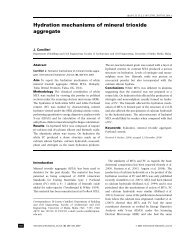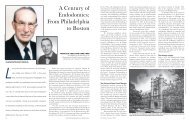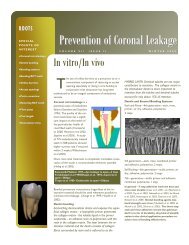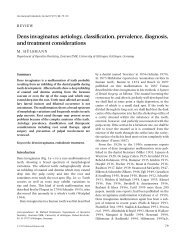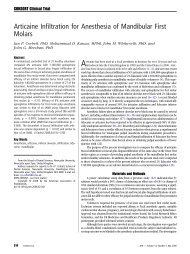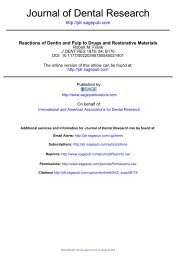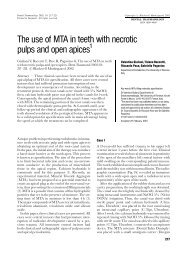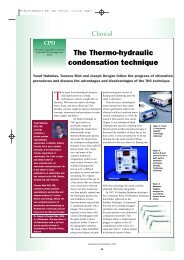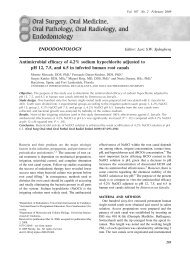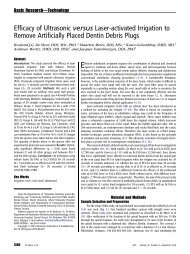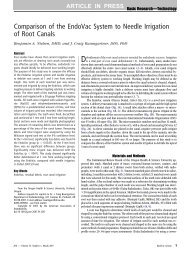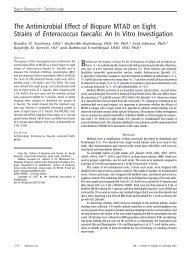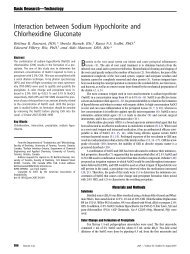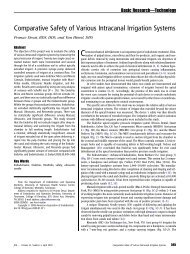Irrigation in Endodontics - The Endoexperience
Irrigation in Endodontics - The Endoexperience
Irrigation in Endodontics - The Endoexperience
Create successful ePaper yourself
Turn your PDF publications into a flip-book with our unique Google optimized e-Paper software.
<strong>Irrigation</strong> <strong>in</strong> <strong>Endodontics</strong> 295<br />
used as a 17% neutralized solution (disodium EDTA, pH 7), but a few reports have <strong>in</strong>dicated<br />
that solutions with lower concentrations (eg, 10%, 5%, and even 1%) remove<br />
the smear layer equally well after NaOCl irrigation. Consider<strong>in</strong>g the high cost of<br />
EDTA, it may be worthwhile to consider us<strong>in</strong>g diluted EDTA. CA is also marketed<br />
and used <strong>in</strong> various concentrations, rang<strong>in</strong>g from 1% to 50%, with a 10% solution<br />
be<strong>in</strong>g the most common. EDTA and CA are used for 2 to 3 m<strong>in</strong>utes at the end of <strong>in</strong>strumentation<br />
and after NaOCl irrigation. Removal of the smear layer by EDTA or CA<br />
improves the antibacterial effect of locally used dis<strong>in</strong>fect<strong>in</strong>g agents <strong>in</strong> deeper layers<br />
of dent<strong>in</strong>. 25,26 EDTA and CA are manufactured as liquids and gels. Although there<br />
are no comparative studies about the effectiveness of liquid and gel products to<br />
dem<strong>in</strong>eralize dent<strong>in</strong>, it is possible that the small volume of the root canal (only a few<br />
microliters) contributes to a rapid saturation of the chemical and thereby loss of effectiveness.<br />
In such situations, the use of liquid products and cont<strong>in</strong>uous irrigation should<br />
be recommended. 27,28<br />
Chlorhexid<strong>in</strong>e Digluconate<br />
Chlorhexid<strong>in</strong>e digluconate (CHX) is widely used <strong>in</strong> dis<strong>in</strong>fection <strong>in</strong> dentistry because of<br />
its good antimicrobial activity. 29–31 It has ga<strong>in</strong>ed considerable popularity <strong>in</strong> endodontics<br />
as an irrigat<strong>in</strong>g solution and as an <strong>in</strong>tracanal medicament. CHX does not possess<br />
some of the undesired characteristics of sodium hypochlorite (ie, bad smell and strong<br />
irritation to periapical tissues). However, CHX has no tissue-dissolv<strong>in</strong>g capability and<br />
therefore it cannot replace sodium hypochlorite.<br />
CHX permeates the microbial cell wall or outer membrane and attacks the bacterial<br />
cytoplasmic or <strong>in</strong>ner membrane or the yeast plasma membrane. In high concentrations,<br />
CHX causes coagulation of <strong>in</strong>tracellular components. 3 One of the reasons for<br />
the popularity of CHX is its substantivity (ie, cont<strong>in</strong>ued antimicrobial effect), because<br />
CHX b<strong>in</strong>ds to hard tissue and rema<strong>in</strong>s antimicrobial. However, similar to other<br />
endodontic dis<strong>in</strong>fect<strong>in</strong>g agents, the activity of CHX depends on the pH and is also<br />
greatly reduced <strong>in</strong> the presence of organic matter. 31<br />
Several studies have compared the antibacterial effect of NaOCl and 2% CHX<br />
aga<strong>in</strong>st <strong>in</strong>tracanal <strong>in</strong>fection and have shown little or no difference between<br />
their antimicrobial effectiveness. 32–35 Although bacteria may be killed by CHX, the biofilm<br />
and other organic debris are not removed by it. Residual organic tissue may have<br />
a negative effect on the quality of the seal by the permanent root fill<strong>in</strong>g, necessitat<strong>in</strong>g<br />
the use of NaOCl dur<strong>in</strong>g <strong>in</strong>strumentation. However, CHX does not cause erosion of<br />
dent<strong>in</strong> like NaOCl does as the f<strong>in</strong>al r<strong>in</strong>se after EDTA, and therefore 2% CHX may be<br />
a good choice for maximized antibacterial effect at the end of the chemomechanical<br />
preparation. 36<br />
Most of the research on the use of CHX <strong>in</strong> endodontics is carried out us<strong>in</strong>g <strong>in</strong> vitro<br />
and ex vivo models and gram-positive test organisms, mostly E faecalis. It is therefore<br />
possible that the studies have given an overpositive picture of the usefulness of CHX<br />
as an antimicrobial agent <strong>in</strong> endodontics. More research is needed to identify the<br />
optimal irrigation regimen for various types of endodontic treatments. CHX is<br />
marketed as a water-based solution and as a gel (with Natrosol). Some studies<br />
have <strong>in</strong>dicated that the CHX gel has a slightly better performance than the CHX liquid<br />
but the reasons for possible differences are not known. 37<br />
Other Irrigat<strong>in</strong>g Solutions<br />
Other irrigat<strong>in</strong>g solutions used <strong>in</strong> endodontics have <strong>in</strong>cluded sterile water, physiologic<br />
sal<strong>in</strong>e, hydrogen peroxide, urea peroxide, and iod<strong>in</strong>e compounds. All of these except<br />
iod<strong>in</strong>e compounds lack antibacterial activity when used alone, and they do not



